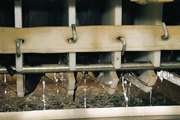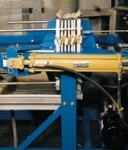Looking For A Better Way To Dewater Sludge?
Appears in Print as: 'Squeezing Money from Your Waste '
Seneca Platers experienced an 82% reduction in weight and a 93% reduction in volume in one-tenth the time...
#pollutioncontrol
Waste minimization and pollution prevention are probably the biggest issues facing platers and finishers. They need an effective and economical way to reduce sludge, which occurs through metal hydroxide sludge dewatering. The most widely used dewatering machines are filter presses. Traditional recessed-chamber filter presses typically produce filter cakes of 25 to 30% solids. Membrane filter presses, the new generation of filter presses, produce filter cakes of 35 to 40% solids. Both types of filter presses, however, require long cycle times, normally between three and four hours. Capital costs start around $20,000 for a six-cu-ft unit.
Seneca Platers, East Aurora, New York, a job shop electroplating company consisting of nine employees, had a problem. It needed a better way to dewater its sludge. The company owned a 10-ft recessed-chamber filter press, but the machine was not performing the way Dean Hayes, vice president, wanted it to. He was running the filter press 45 hours a week (three cycles a day, three hours per cycle, five days a week), but was not satisfied with the results. Weekly, the filter press was reducing the 24 cu ft of liquid sludge down to three cu ft of filter cake. The filter cakes were stored in 55-gal barrels, which were later hauled away for proper disposal. Seneca was filling and shipping 24 barrels a year. When each barrel costs up to $500 to be hauled away, an annual disposal fee of up to $12,000 was expected. That's a large bill for any size company to pay. Twelve thousand dollars, combined with the large amount of operating time, made Mr. Hayes wonder if there was a faster, more efficient way to dewater plating sludge. With landfill space at a premium and government regulations becoming stricter every year, Mr. Hayes wanted a dewatering method with shorter cycle times and higher cake solids, thus reducing costs to safely and properly dispose of his waste.
Featured Content
In 1995, Mr. Hayes found the solution. That year, he purchased a dewatering press from a local engineering firm. The new dewatering press uses mechanical pressure from hydraulic cylinders to squeeze liquid out of sludge. The mechanical dewatering press (MDP) has proved to be a valuable piece of equipment.
The new MDP did two things for Seneca Platers: 1) It decreased cycle time from 45 hours a week to less than four hours on Friday mornings, a 91% reduction in operation time; and 2) It reduced the sludge volume from 24 cu ft a week to 1.5 cu ft, an 82% weight reduction and a 93% volume reduction. Moreover, the 1.5 cu ft of dry filter cake represents a 50% reduction of what Seneca's filter press had been producing. That 50% reduction means shipping only 12 barrels of dry waste a year (instead of 24). That translates into a 50% savings ($6,000) a year on waste disposal, instead of the previous $12,000 a year.
Operating a manual dewatering press is simple. Before pressing, 30cc of polymer is added to five gal of water. These five gal of polymer/water mixture are added to 90 gal of sludge. Polymer, which is also used in standard filter presses, thickens the sludge into an "oatmeal" consistency, making it easier to extract water. Mr. Hayes estimates that Seneca has used about two-and-a-half gal of polymer during the more than three years it has been operating. Using gravity flow, the sludge is top-loaded into the filter bags that are sandwiched between patented grooved racks. The open bag design acts as a pressure-relief feature, eliminating pressure-related breakdowns that can sometimes occur with filter presses. Once bags are filled, a hydraulically driven moving platen is engaged, compressing the racks together and squeezing the liquid out of the porous filter bags.
After a brief squeezing sequence, the cylinders are retracted to their set position. The pressing module, which houses the filter bags and grooved racks, is then rotated 180 degrees on a center pivot axis, allowing all the dry cakes to be discharged at once. This center pivot feature eliminates the need to shift each plate and remove individual cakes. The module is then returned to its upright position and is ready to be refilled. Each cycle, according to Mr. Hayes, takes maybe five minutes.
"I usually run the press between three and four hours on Friday mornings," said Mr. Hayes. "If I was running the filter press all day every day, I'd have to clean it three times a day, too," he added.
"In a standard filter press, if you don't leave it (the sludge) long enough, it doesn't get dry," he said. "You have to fill the filter press, and then you have to let it sit there and hold pressure to drive the water out," said Mr. Hayes.
Mr. Hayes estimates that the filter cakes exit the press at 50 to 60% solids. "The sludge cakes are dry enough that they snap." This filter press can make the cake drier, but there is a balance between the dryness you want and the time needed to reach that dryness. He recalled one instance when he needed to answer a telephone call and left the press in the squeezing mode. When he returned a short while later, the cakes came out like "stone."
Because of shorter cycle times in the mechanical dewatering press, the equivalent sized filter press will have a much larger capacity per batch. For example: an MDP with a dry cake throughput of one cu ft per cycle normally runs six cycles per hour; therefore, its hourly dry cake throughput is six cu ft. To find the equivalent sized filter press, one needs to multiply the MDP's hourly dry cake throughput by the number of hours it takes to complete the average filter press cycle. If a filter press has an average cycle time of four hours, then the equivalent filter press is a 24-cu-ft unit (six cu ft of hourly dry cake throughput on the MDP x four-hour filter press cycle time).
The high cake solids produced by this press will result in a smaller volume of dry filter cakes. A smaller volume of filter cake means less money will have to be spent on the proper and safe disposal of plating waste. Reduced capital costs combined with lower volumes of waste to be disposed add up to significant dollar savings.
"We looked into (filter presses), but they're all huge," said Mr. Hayes. "You have to produce the volume of sludge needed to fill the filter press." Operators need a minimum amount of sludge to run a given size filter press. For example: if a filter press has a five-cu-ft capacity, a minimum of five cu ft of sludge is needed to make the filter press work. If a filter press has a 10-cu-ft capacity, a minimum of 10 cu ft of sludge is required. The problem of needing a minimum amount of sludge does not exist with mechanical dewatering technology, since the filter bags do not need to be full for the press to run. "I can run two gallons through this and make it dry. With this, it doesn't matter how much sludge you run." This is true because this press uses mechanical pressure, rather than pump pressure, to extract liquid from sludge.
Maintenance and durability were important factors that Seneca Platers considered when it was looking for a new press. Mr. Hayes remarked on the advantages of the mechanical dewatering press in these two important categories. "There are no wear parts on this type of press, which means there is very little maintenance.
"Another thing I'm impressed with," Mr. Hayes said, "is the finish on this machine. The corrosion resistant powder-coating on this press makes a big difference. Some stuff you buy and dread it; I don't dread doing this at all on Fridays because it's so much easier now," Mr. Hayes said with a smile.
RELATED CONTENT
-
Zinc Electroplating
Choosing the best process for your operation.
-
Cleaning, Pretreatment to Meet Medical Specs ISO 13485 or FDA 21 CFR820
Maximilian Kessler from SurTec explains new practices for industrial parts cleaning, metal pretreatment and decorative electroplating in the medical device industry.
-
Gold and Silver Plating Basics
An overview of precious metal electroplating processes.





















